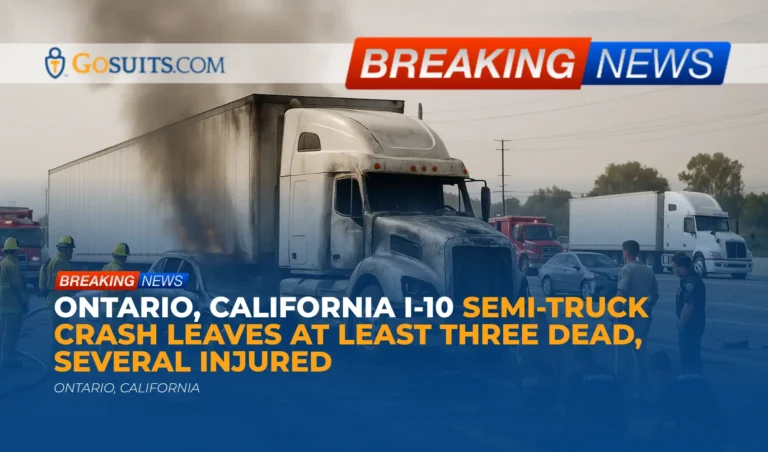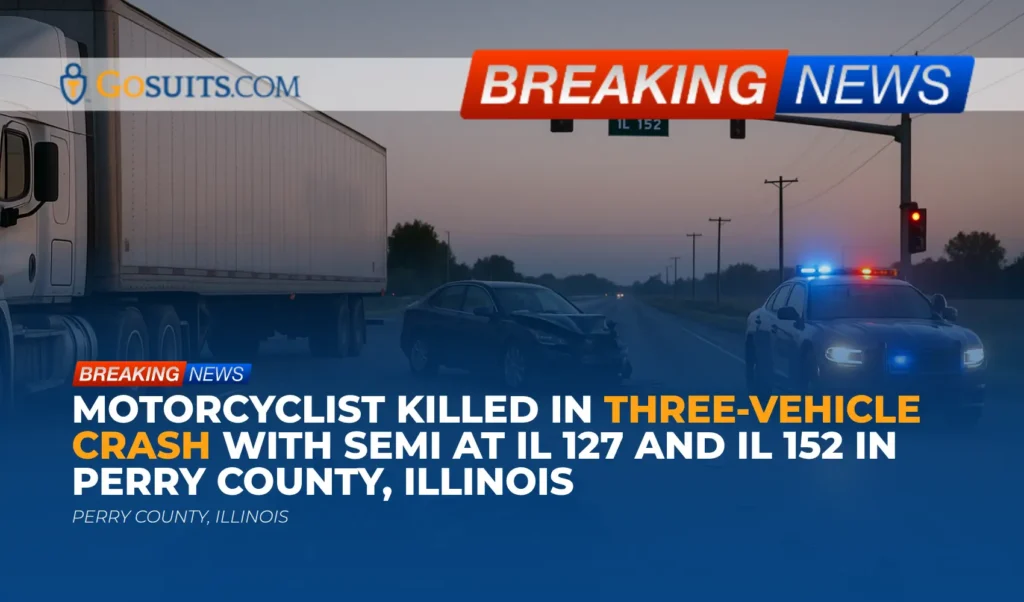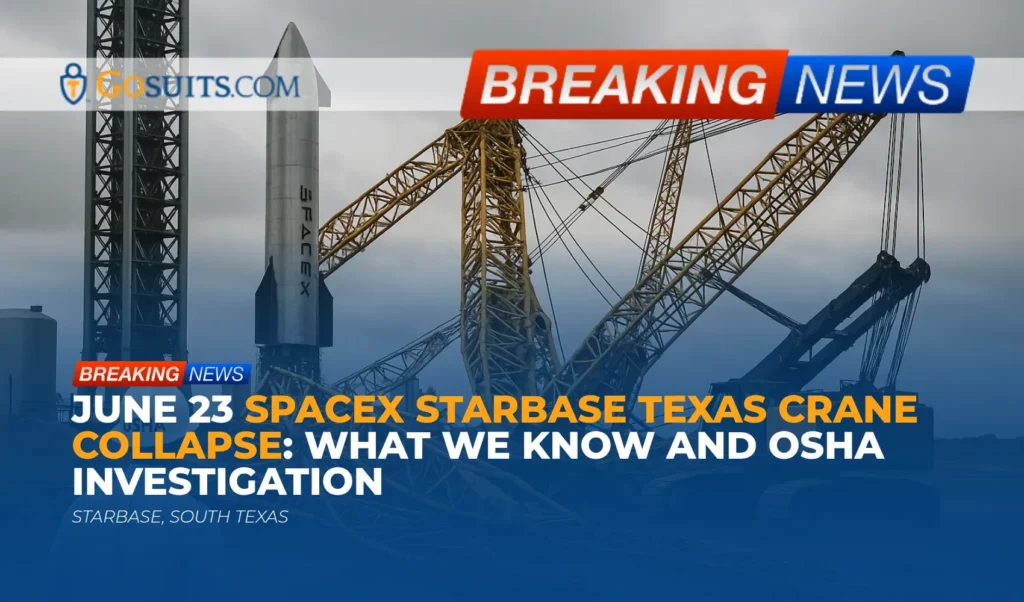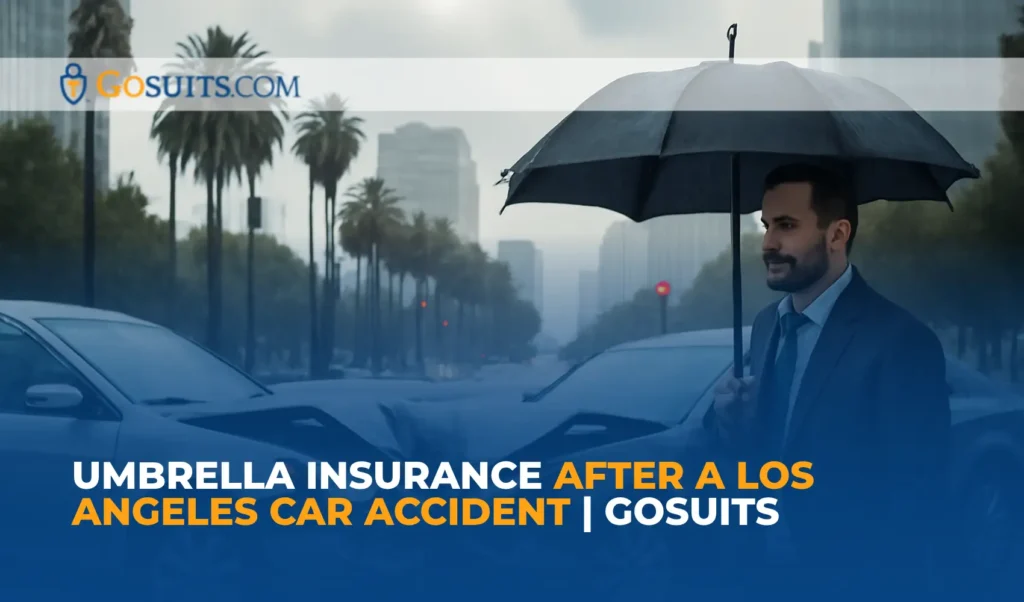- What We Know About the Ontario I-10 Semi-Truck Crash
- Who Was Involved and Which Agencies Responded
- How Commercial Truck Crashes Are Investigated
- How to Obtain Official Records: Police Report, Autopsy, and Death Certificates
- Key California Civil Law Considerations After a Fatal Truck Collision
- Potential Civil Liability: Driver, Motor Carrier, and Others
- Insurance, Coverage Layers, and Practical Claim Considerations
- Rights, Deadlines, and Why Timing Matters
- Immediate Steps to Help Protect a Civil Claim
- Victim Support and Practical Resources
- Safety Notes for the Community
- Commentary from Gosuits Ontario, California Personal Injury Attorney
- Why Timely Action Matters After a Catastrophic Truck Crash
What We Know About the Ontario I-10 Semi-Truck Crash
Authorities and multiple reports describe a catastrophic multi-vehicle collision on the westbound lanes of the I-10 Freeway in Ontario, California. The incident occurred early afternoon on a Tuesday, around 1 p.m., when a westbound semi-truck reportedly failed to brake for slowed or stopped traffic. The high-speed impact set off a chain reaction that involved multiple tractor-trailers and passenger vehicles. At least three people lost their lives and several others were injured. A post-impact fire was reported, and westbound lanes were closed for hours as firefighters and law enforcement worked to extinguish the flames, render aid, and clear wreckage.
The truck’s driver, a 21-year-old from Yuba City, was detained at the scene. Officials stated the driver appeared impaired, and toxicology testing is pending. Authorities indicated there was no evidence the driver braked prior to impact. At the time of the latest updates, the names of the deceased had not yet been released pending notification of next of kin.
Witness accounts and dash camera footage circulating on social media show the scale of the crash, including a violent secondary impact and the ensuing fire. Law enforcement has asked witnesses with firsthand information, photos, or dashcam video to contact investigators.
Who Was Involved and Which Agencies Responded
Based on official and widely reported details, the collision occurred within San Bernardino County, in the City of Ontario, on the I-10 westbound. The responding agencies and public offices include:
- California Highway Patrol (CHP): Primary investigation and traffic incident management. The CHP typically leads freeway crash investigations, including scene documentation, vehicle inspections, and witness interviews.
- Local Fire/EMS: Fire suppression, extrication, and patient transport.
- San Bernardino County Sheriff-Coroner: Death investigations, identification, and coordination of next-of-kin notifications.
- San Bernardino County District Attorney’s Office: Review of any potential criminal charges is separate from, and does not control, civil liability.
Reports also discussed unverified claims circulating online regarding immigration status. As of the latest information, federal agencies had not issued public confirmation of those claims. In civil personal injury and wrongful death matters, liability determinations rest on facts such as negligence and causation, not immigration status. California law generally protects against revealing immigration status in civil cases unless a court finds it admissible for a specific, lawful purpose, and even then subject to strict procedures. See California Evidence Code section on immigration status protections for civil litigants at the state’s legislative information site, available via the Legislative Counsel’s website.
How Commercial Truck Crashes Are Investigated
Serious freeway collisions involving large trucks are methodically reconstructed. CHP investigators typically analyze:
- Physical evidence at the scene: Skid marks, yaw marks, gouges, debris fields, vehicle rest positions, and burn patterns.
- Vehicle inspections: Braking systems, tires, lighting, and other safety-critical components.
- Electronic data: Heavy trucks often contain engine control module (ECM) data and electronic logging device (ELD) records of driving time and speed. Federal rules require carriers to retain ELD records and supporting documents for a period of months. See federal hours-of-service and ELD record retention at FMCSA.
- Carrier records: Federal motor carrier regulations require carriers to maintain an accident register and records relevant to crashes, driver qualification, and drug and alcohol testing. See 49 CFR 390.15 and related safety recordkeeping discussed at FMCSA.
- Post-crash toxicology: Federal regulations require post-accident testing in specified circumstances for commercial drivers, referenced in 49 CFR Part 382 and outlined at FMCSA’s drug and alcohol testing overview.
- Witness statements and video: Dashcams, commercial surveillance, cellphone footage, and 911 recordings.
These findings often inform both criminal considerations and entirely separate civil liability assessments. A civil claim focuses on whether negligent acts or omissions caused harm and the full scope of damages under state law.
How to Obtain Official Records: Police Report, Autopsy, and Death Certificates
CHP Traffic Collision Report
Next of kin, involved parties, and their representatives can request the CHP collision report. The California Highway Patrol provides instructions and a request form for obtaining a traffic collision report. See “How to Obtain a Traffic Collision Report” at the official CHP site: CHP Collision Report Requests.
When submitting, provide as much information as possible: date, time, location (I-10 westbound in Ontario), parties involved, and the investigating CHP office.
Autopsy and Coroner Records
Because the crash occurred in San Bernardino County, death investigations are handled by the San Bernardino County Sheriff-Coroner. Families seeking autopsy findings, cause and manner of death information, or assistance with the release of remains should begin with the Sheriff-Coroner’s official page: San Bernardino County Sheriff-Coroner.
The coroner can advise next of kin about what records can be released, how to request them, and expected timelines. Some portions of coroner files may be limited during an active investigation.
Death Certificates
Certified copies of death certificates in California are issued through the California Department of Public Health (CDPH) Vital Records. Information and ordering options are available at California Department of Public Health – Vital Records.
Victim Compensation
For families facing unexpected funeral and burial costs, California’s Victim Compensation Board may provide assistance in qualifying cases, including crimes involving impaired driving. Learn more at California Victim Compensation Board.
Key California Civil Law Considerations After a Fatal Truck Collision
Wrongful Death and Survival Actions
California recognizes two related civil actions after a fatal incident:
- Wrongful death: This compensates eligible family members for losses they personally suffer because of a loved one’s death. Eligibility and the nature of recoverable damages are set out in California Code of Civil Procedure section 377.60 and following. See the current statutory text at the state’s legislative site: California Codes – CCP §377.60.
- Survival action: This allows the decedent’s estate to recover certain damages the decedent could have claimed had they survived, such as medical bills and, in many cases now, limited pre-death pain, suffering, or disfigurement. See CCP §377.30 et seq. and §377.34 at California Codes – CCP §377.34.

DUI and Civil Liability
Driving under the influence is addressed in California Vehicle Code §23152, including subsection (f) for driving under the influence of a drug. The vehicle code itself can be accessed through the Legislative Counsel’s website: California Vehicle Code – §23152. Evidence of impairment, when supported by admissible proof, can strongly bear on civil negligence, breach of duty, and punitive damages analysis. That said, toxicology results and full investigative findings often take time and should be awaited before drawing conclusions.
Comparative Fault
California follows comparative fault, which allows responsibility to be apportioned among multiple parties based on their percentage of fault. The Judicial Council’s civil jury instructions explain how juries may evaluate comparative fault. See the Judicial Council of California’s site for guidance on comparative fault concepts in civil cases: Judicial Council of California.
Potential Civil Liability: Driver, Motor Carrier, and Others
In a multi-vehicle, heavy-truck crash of this magnitude, civil liability analysis typically considers several potential at-fault actors. The facts below are general considerations and do not assign fault in this specific case, which remains under investigation.
- Commercial driver: A driver may be liable for negligent operation, including speeding, following too closely, failing to brake, or driving while impaired.
- Motor carrier/employer: Employers can be vicariously liable for employees’ negligence within the scope of employment. Separate claims may arise for negligent hiring, retention, training, or supervision if safety lapses are proven. Federal rules require motor carriers to conduct driver qualification checks and to follow drug and alcohol testing rules. See FMCSA’s overview of drug and alcohol rules at FMCSA.
- Regulatory compliance: Investigations often review compliance with hours-of-service limits and recordkeeping under 49 CFR Part 395, vehicle inspection and maintenance under 49 CFR Part 396, and accident record requirements under 49 CFR 390.15. Summaries and rule text are available through FMCSA Regulations.
- Vehicle defects and maintenance: If braking or other critical systems failed, maintenance providers or parts manufacturers may be examined for potential product or service defects, depending on investigative findings.
- Other drivers: In multi-vehicle collisions, other motorists’ conduct may also be assessed, though initial reports here center on a single truck’s failure to brake.
It is important to emphasize that immigration status does not determine civil fault. California evidentiary rules restrict the use of immigration status in civil proceedings unless a court finds a narrow and lawful reason that requires disclosure after specific procedures. Families should focus on facts that bear on causation, negligence, and damages.
Insurance, Coverage Layers, and Practical Claim Considerations
Interstate motor carriers must demonstrate financial responsibility at federally mandated minimums, often through liability insurance. For general freight, the federal minimum is typically $750,000, though many carriers carry higher limits and excess policies. See 49 CFR Part 387 for minimum levels of financial responsibility, summarized at FMCSA – 49 CFR §387.9.
In a catastrophic loss with multiple victims, several layers of coverage may be implicated:
- Primary liability insurance for the motor carrier.
- Excess/umbrella policies that sit above primary limits.
- Other potentially responsible parties’ policies, if investigations reveal additional fault.
Insurance adjusters for trucking companies and their insurers may seek recorded statements early. It is prudent to consult a qualified attorney before speaking to any insurer. What someone says to an insurance company can be used against them later, even when grief is fresh and facts are incomplete. Initial guidance is commonly available at no cost through a free consultation, which can help families understand the process and their rights before any statements are given.
Rights, Deadlines, and Why Timing Matters
California sets deadlines for civil claims. Many wrongful death and personal injury claims must be filed within two years from the date of the incident under California Code of Civil Procedure §335.1. The current statutory text is available at the Legislative Counsel’s official site: California Codes – CCP §335.1.
If any government entity could be implicated, special claim rules and a much shorter timeframe may apply. State law requires a government claim to be filed in as little as six months for certain claims under the Government Claims Act. Guidance for claims against state agencies appears at the Department of General Services Government Claims Program: California DGS – Government Claims Program. Claims against local public entities have separate procedures with the specific entity.
Timely action matters because electronic data, dashcam footage, vehicle components, and witness recollections can be lost or degrade. Federal rules require certain records to be kept only for limited periods, such as hours-of-service and ELD data, which carriers are generally required to retain for months, not permanently. See federal hours-of-service recordkeeping at FMCSA.
Immediate Steps to Help Protect a Civil Claim
These are general steps families often consider after a catastrophic truck crash. They are educational in nature and not case-specific advice.
- Request official records: Initiate requests for the CHP collision report and, for families of the deceased, coroner records and death certificates through the official links above.
- Preserve evidence: Save all relevant phones, photos, dashcam footage, vehicle event data, and personal items. Avoid deleting texts, call logs, or location data related to the day of the crash.
- Send preservation notices: Through counsel, send written preservation letters to the motor carrier and any involved businesses requesting retention of ECM, ELD, driver qualification files, drug and alcohol testing records, training records, dispatch communications, and post-crash vehicle inspections. Federal regulations require carriers to maintain certain records; a preservation notice helps ensure they are not discarded when retention periods expire. See FMCSA recordkeeping concepts at FMCSA Regulations.
- Avoid recorded statements without guidance: Insurance representatives may call early. Before any discussions, consult an attorney to understand rights and potential pitfalls. Statements can be used later and may affect liability and damages evaluations.
- Track expenses and losses: Keep organized records of medical bills, funeral and burial costs, lost income, and other crash-related impacts.
- Coordinate with the coroner: For families, maintain communication with the San Bernardino County Sheriff-Coroner regarding identification, release of remains, and the process for obtaining reports when available: San Bernardino County Sheriff-Coroner.
Victim Support and Practical Resources
- California Highway Patrol Witness Information: If you witnessed the crash or have dashcam footage, contact CHP and reference the I-10 westbound Ontario incident. General guidance on collision reporting is available here: CHP – Obtain a Traffic Collision Report.
- San Bernardino County Sheriff-Coroner: For death investigations, notifications, and record requests, see: Sheriff-Coroner.
- Death Certificates: California Department of Public Health Vital Records: CDPH Vital Records.
- Financial Assistance: California Victim Compensation Board for qualifying funeral/burial and counseling assistance in eligible cases: CalVCB.
Safety Notes for the Community
Large trucks require substantially longer stopping distances, especially at highway speeds and when fully loaded. National safety data consistently show the severe consequences of large-truck crashes. The National Highway Traffic Safety Administration publishes annual traffic safety facts for large trucks, including fatality counts and contributing factors. See NHTSA’s data portal for authoritative statistics and reports at NHTSA.
Community reminders that help reduce risk include:
- Never drive impaired: Alcohol, drugs, and certain medications impair reaction time and judgment. California Vehicle Code §23152 prohibits driving under the influence, including drugs. The statutory text is available through the Legislative Counsel’s site.
- Allow space near big rigs: Avoid lingering in blind spots, leave ample following distance, and anticipate that trucks need more room to stop.
- Report dangerous driving: If you observe erratic or impaired driving, safely contact law enforcement.

Commentary from Gosuits Ontario, California Personal Injury Attorney
Our hearts are with the families and everyone affected by this devastating crash on the I-10 in Ontario. Losing a loved one in a violent, unexpected collision is a life-altering tragedy. This article is offered for general information to help the community understand what typically follows a crash of this magnitude and where crucial information can be obtained.
From a civil perspective, the early facts raise urgent questions about speed, braking, and potential impairment by a commercial driver in congested freeway traffic. When a heavy truck fails to slow for stopped or slow-moving vehicles, the energy transfer is unforgiving, and multiple vehicles can be caught in a chain reaction, as appears to have happened here. The full investigative record, including ECM data, ELD logs, video evidence, mechanical inspections, and toxicology, will matter greatly in determining civil responsibility.
Online discussions have included unverified claims regarding immigration status. In civil wrongful death and injury law, liability turns on negligence and causation, not a person’s immigration status. California law generally restricts inquiries into immigration status in civil cases unless narrowly justified and approved by a court following strict procedures. The focus should remain on evidence that explains how and why the crash occurred and the full measure of harm it caused.
In the aftermath of catastrophic trucking collisions, insurance companies and corporate defendants often move quickly. Adjusters may ask for recorded statements or signed authorizations before families have the opportunity to understand their rights or the scope of available evidence. Complex coverage issues and federal safety rules can be difficult to navigate without guidance. It is common for carriers to hold detailed operational data for limited periods, and once retention windows close, key records can disappear in the ordinary course.
Obtaining a free consultation with a seasoned and skilled personal injury attorney before speaking with any insurer can help level the playing field. Initial discussions can explain how claims are evaluated, what evidence should be preserved, and how communications with insurance companies may affect a civil case. What a person says to an insurer can be used against them later, and families should not feel pressured to give statements while grieving or before the facts are fully known.
Why Timely Action Matters After a Catastrophic Truck Crash
Here are practical reasons to act promptly and what action looks like in clear terms:
- Secure time-sensitive evidence: Electronic logging device data, engine control module downloads, dispatch communications, and surveillance video may be kept only for limited periods. Acting now means preservation letters can be sent, and requests for data can be made before routine deletion.
- Obtain official documents early: Traffic collision reports, coroner records, and death certificates provide foundational facts. Early requests help align medical, funeral, and civil claim needs with verified information.
- Avoid harmful recorded statements: Insurance representatives may seek statements quickly. Consulting an attorney first helps ensure communications protect, rather than compromise, a future claim.
- Meet legal deadlines: California’s civil filing deadlines can be as short as two years for wrongful death and personal injury, and as little as six months for some government-related claims. Acting early helps ensure no deadline is missed.
- Understand coverage and responsibility: Trucking claims may involve multiple policies and parties. Early analysis can identify all potential sources of recovery and assign preservation tasks appropriately.
- Support grief and logistics: Death certificates, coroner coordination, and CalVCB assistance can help with immediate needs like funeral arrangements and financial support in qualifying situations.
Specific next steps typically include gathering documents, requesting official reports, preserving electronic and physical evidence, and seeking a free consultation with a trusted attorney for individualized guidance before any conversations with insurers. Taking these steps early can help protect a family’s rights while honoring their need for space and care.






